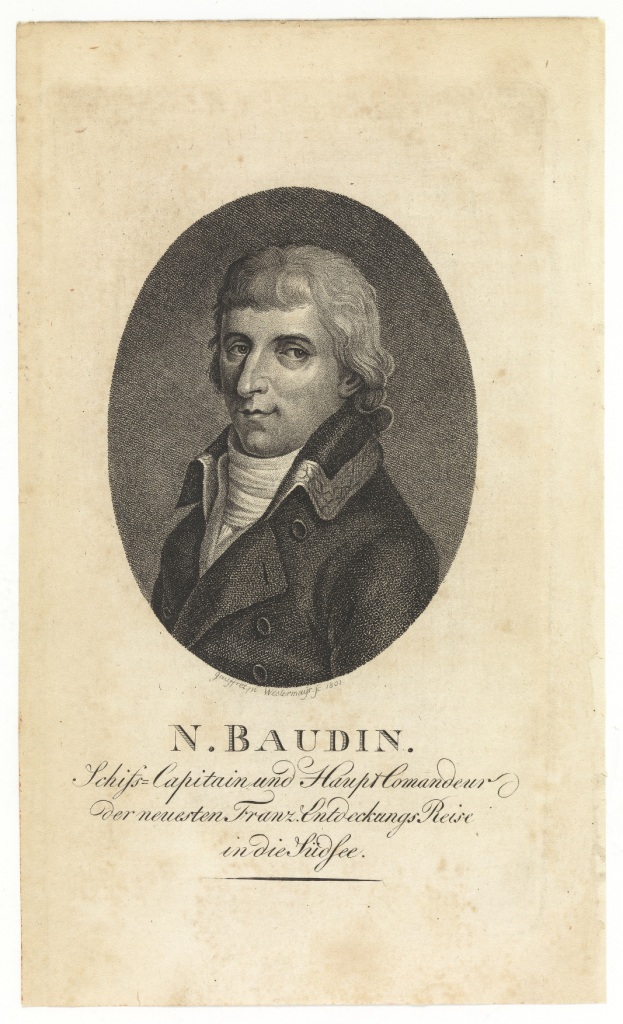The Early Years
Tucked away on South Australia's rugged Limestone Coast, Robe has a remarkable history. The town overlooks picturesque Guichen Bay, first charted in 1802 by French explorer Nicolas Baudin, as part of a major scientific expedition approved by Napoleon Bonaparte. Baudin named the bay Ances des Albatross, but this was changed after he died on the way home, to honour a French admiral, the Comte de Guichen.

Image: Nicolas Baudin
For at least 30,000 years, the area was home to the Bunganditj and Meintangk peoples. A large and stable population is believed to have lived along the coastline, sustained by rich local food sources such as shellfish and muntries.
Sealers visited Guichen Bay long before the colony of South Australia was founded in 1836, and famous overlander Charles Bonney passed through with a mob of cattle in 1839. However, it was not until 1846 that a town was established to meet the needs of pastoralists settling in the area.
It was named after Governor Frederick Holt Robe, who inspected the area in January 1846 and chose Guichen Bay as the preferred location for a port. The township was surveyed three months later, and the first allotments sold at auction in October. Within days, a small party of government officials arrived, led by distinguished British solder Captain Gerald Villiers Butler, who was appointed Government Resident in charge of an area covering some 6000 square kilometres.
In a little known aspect of the story, Butler was accompanied from the very first day by his pregnant wife Charlotte, their four children, and three servants, including a manservant, Gill, a woman by the name of Anne who helped look after the children, and a female cook. After three testing days trapped onboard the government cutter, Lapwing, because of rough weather, Charlotte and the children were finally rowed ashore, where a tent, a warming campfire and a hot cup of tea awaited them.
Robe's maritime heritage
After a slow start, Robe became one of the most important ports on Australia's southern coast, serving a large hinterland that stretched into western Victoria. In the late 1850s, more than 15,000 Chinese landed in the bay on their way to the Victorian goldfields, as part of one of the most remarkable treks in Australian history. They travelled via Robe after a tax of £10 per head was placed on Chinese landing at ports in Victoria.
In the ten-year period up to 1866, wool worth more than £1 million also passed through the port, on its way to British mills. Almost all of it was handled by shipping merchant George Ormerod, one of the most prominent figures in the development of the town. Originally from Lancaster, he established his business in 1853, operating a warehouse and store on the Royal Circus, which served as a roundabout for teamsters delivering wool from outlying stations. During peak season, their wagons often stretch several kilometres out of town while they waited to unload.
Today the Royal Circus serves as the central location commemorating Robe's maritime heritage, and shipwrecks that occurred in the treacherous waters of the Limestone Coast. Taking pride of place are bronze sculptures of Baudin and one of England's most famous navigators, Matthew Flinders, who visited the bay a few days after his French counterpart. They stand alongside a cannon, believed to have come from the Dutch ship Koning Willem II, which came to grief during a storm in the bay in 1857, resulting in the tragic loss of 16 crew members.
Overlooking the Royal Circus is the Customs House, one of more than 70 heritage-listed buildings in the town and surrounding area. The list includes Robe's most famous landmark, the Obelisk, erected in 1855 to guide ships into the bay, and what could be described as the town's first summer holiday home, Karatta. Designed by colonial architect Edward Angas Hamilton, the grand two-storey home was built in 1862 by Henry Jones from Binnum Binnum station, so his wife could escape the inland heat. In the early 1870s, the house was leased as a summer residence for Governor Sir James Fergusson and his family.
Famous figures
During its boom years, Robe was not only the administrative centre of the Limestone Coast region, but the commercial and cultural hub, with thriving businesses, pubs, churches and privately run schools serving the townspeople and outlying stations.
Well known for the quality of its horses, the district hosted regular race meetings, drawing famous Australian poet and horseman, Adam Lindsay Gordon, who married a local girl, Maggie Park. Another talented horseman, who started his career at Robe, was Tommy Hales. Now recognised as Australia's greatest jockey of the 19th century, he went on to win every major race in the country. The pinnacle of his career was claiming the 1880 Melbourne Cup.
The colony's Superintendent of Telegraphs, Sir Charles Todd, came to Robe in the late 1850s to build Australia's first inter-colonial telegraph line, connecting Adelaide and Melbourne. He sent the very first telegram from Robe's new telegraph office, on the foreshore near the Robe Hotel, in June 1858.
Another well known public official, controversial South Australian police commissioner, Alexander Tolmer, lived in Robe for almost ten years. Best known for leading the gold escorts which saved the colony from economic ruin during the Victorian goldrush, Tolmer was appointed the local inspector ranger after being demoted in the police force, and trying his hand at being a pastoralist, merchant trader and explorer.
As the first Catholic priest appointed permanently to serve the region, Father Julian Tenison Woods was a frequent visitor to Robe. Aside from serving his parishioners, the talented scientist spent many hours exploring the countryside on horseback, with a geological hammer tucked into his saddle bag alongside his bible. Woods served the area for ten years from 1857, overseeing the building of St Mary's Star of the Sea, one of the oldest Catholic churches in South Australia.
His main base was Penola, where he famously encouraged a young governess by the name of Mary MacKillop to open a school and establish the Sisters of St Joseph of the Sacred Heart. Canonised in 2010 as Australia's first saint, Mother Mary set up another school in Robe's Catholic church not long after founding the order, with two nuns assigned at a time to run it.
Summer, sheep and surf
Despite promising beginnings, Robe fell into decline within a few decades of settlement because of the establishment of rival ports and railway systems that bypassed the town, and struggles in the pastoral sector. Then in the early 1900s, the town reinvented itself as a holiday destination, promoted as the Sanatorium of South Australia, because of the therapeutic value of its sea air and salt waters. As more families acquired motor cars in the 1920s, it became a popular spot for 'motor camping', with a new progress association setting up the first official camping ground, nestled in dips and hollows between the town and West Beach.
The late 1930s saw a change in fortune for the area's farmers when scientists carrying out research near Robe confirmed the cause and worked out a cure for coast disease, a wasting condition that affects livestock grazed in coastal areas. The CSIRO established a field station on Bob Dawson's small farm after he volunteered to set aside some land and sheep. In a breakthrough of international importance, the research confirmed the condition was caused by deficiencies in cobalt and copper. Bob received an MBE in 1950 for his contribution. He and his son Vic assisted with monitoring and writing reports for more than 40 years.
In the 1940s, the local economy further improved when commercial fishing took off. The first major catch was not southern rock lobster, for which the town is now well known, but gummy sharks. The sharks were processed for their livers, to provide an oil rich in vitamins to fortify military rations during World War Two. Lobster came into its own in the 1950s, when the fishing fleet grew substantially and exports began to the United States. Driving the charge was Australia's first fishing cooperative, SAFCOL, which was officially formed at a meeting of South East fishermen held in Robe in 1944.
Another new era emerged in the 1960s, when surfing came to Robe. First held in 1968, the Robe Easter Surfing Classic is recognised as one of the oldest continuously held surfing competitions in the world, most likely only second to famous Bell's Beach.
